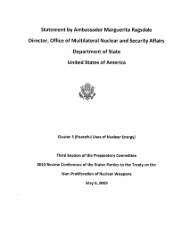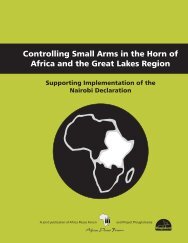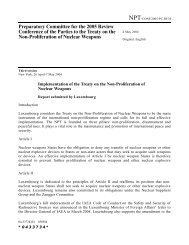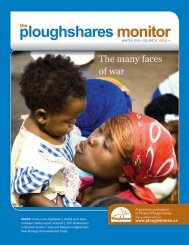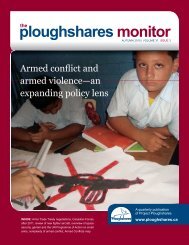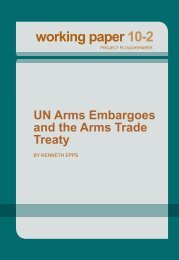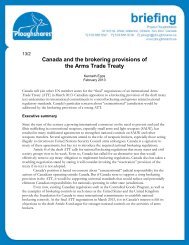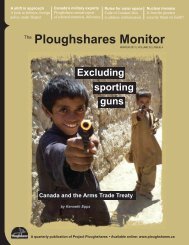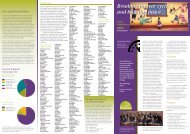Addressing Armed Violence in East Africa.pdf - Project Ploughshares
Addressing Armed Violence in East Africa.pdf - Project Ploughshares
Addressing Armed Violence in East Africa.pdf - Project Ploughshares
You also want an ePaper? Increase the reach of your titles
YUMPU automatically turns print PDFs into web optimized ePapers that Google loves.
<strong>Address<strong>in</strong>g</strong> <strong>Armed</strong> <strong>Violence</strong> <strong>in</strong> <strong>East</strong> <strong>Africa</strong>Jo<strong>in</strong>t StatementJo<strong>in</strong>t Statement by <strong>Project</strong> <strong>Ploughshares</strong> and World Vision Canadaon Development, Peacebuild<strong>in</strong>g and <strong>Armed</strong> <strong>Violence</strong> Reduction<strong>Project</strong> <strong>Ploughshares</strong> and World Vision Canada are pleased to publish this report based on2008 field research <strong>in</strong> <strong>East</strong> <strong>Africa</strong> on armed violence reduction and World Vision peacebuild<strong>in</strong>gand development activities. The research report itself attempts to faithfully document whatwas heard and seen dur<strong>in</strong>g the three weeks that <strong>in</strong>terviews were conducted <strong>in</strong> selected parts ofKenya, Uganda and Sudan. Observations are provided based on the research but conclusions andrecommendations were deliberately excluded from the report proper because of the constra<strong>in</strong>tsdescribed <strong>in</strong> the Methodology section.We will not be so reserved <strong>in</strong> this jo<strong>in</strong>t statement. The recommendations below are <strong>in</strong>tended tofocus discussion with and among donors, partner country governments, government foreign anddefence policy makers, colleagues <strong>in</strong> Northern and Southern non-governmental organisations(NGOs) and academic <strong>in</strong>stitutions on how the f<strong>in</strong>d<strong>in</strong>gs <strong>in</strong> this report can and should beused to formulate policy and direct programm<strong>in</strong>g to advance development effectiveness andreduce armed violence. Our complementary mandates shape the recommendations. <strong>Project</strong><strong>Ploughshares</strong>’ mandate is to identify, develop, and advance approaches that build peace andprevent war. World Vision’s mandate is to see every child experience life <strong>in</strong> all its fullness, as wework with children, families and communities to overcome poverty and <strong>in</strong>justice.Our research partnership arose from a common cause. The project was formed on the basis ofprior commitments <strong>in</strong> both organisations to contribute to the grow<strong>in</strong>g body of evidence-basedresearch document<strong>in</strong>g the important l<strong>in</strong>k between reduc<strong>in</strong>g armed violence and <strong>in</strong>creasedeffectiveness of peacebuild<strong>in</strong>g, development and humanitarian relief programm<strong>in</strong>g. World VisionInternational has made a world-wide organisational commitment to address<strong>in</strong>g violent conflict<strong>in</strong> its programm<strong>in</strong>g because without this cross-cutt<strong>in</strong>g focus, its work and <strong>in</strong>vestments <strong>in</strong> localcommunity development risk be<strong>in</strong>g underm<strong>in</strong>ed and even squandered. <strong>Project</strong> <strong>Ploughshares</strong>’research and policy work to stop the uncontrolled proliferation of conventional arms—particularly small arms and light weapons—has <strong>in</strong>creas<strong>in</strong>gly been focused on the demand factors<strong>in</strong> arms proliferation. Why do people believe that they need guns, and how do we f<strong>in</strong>d ways forpeople to feel safe without them? The answers generally come from development programm<strong>in</strong>grather than disarmament processes.In 2008, <strong>in</strong> an effort to assess the full scope and impact of worldwide violence, the Secretariat ofthe Geneva Declaration on <strong>Armed</strong> <strong>Violence</strong> and Development published the Global Burden of<strong>Armed</strong> <strong>Violence</strong>. This study affirms that the more than 100 state signatories to the 2006 GenevaDeclaration “…recognize that effective prevention and reduction of armed violence requiresstrong political commitment to enhance national and local data collection, develop evidencebasedprogrammes, <strong>in</strong>vest <strong>in</strong> personnel, and learn from good practice.” 1This study offers one “brick” <strong>in</strong> what we trust will become a ris<strong>in</strong>g wall of field-based evidenceto advance best practices <strong>in</strong> reduc<strong>in</strong>g armed violence. But other commitments also needimplement<strong>in</strong>g. The Geneva Declaration calls on signatories to “strengthen efforts to <strong>in</strong>tegratestrategies for armed violence reduction and conflict prevention <strong>in</strong>to national, regional, andmultilateral development plans and programmes.” 2 Hence, our recommendations:1 http://www.genevadeclaration.org/<strong>pdf</strong>s/Global-Burden-of-<strong>Armed</strong>-<strong>Violence</strong>.<strong>pdf</strong>, p.42 Ibid., p 4.4



